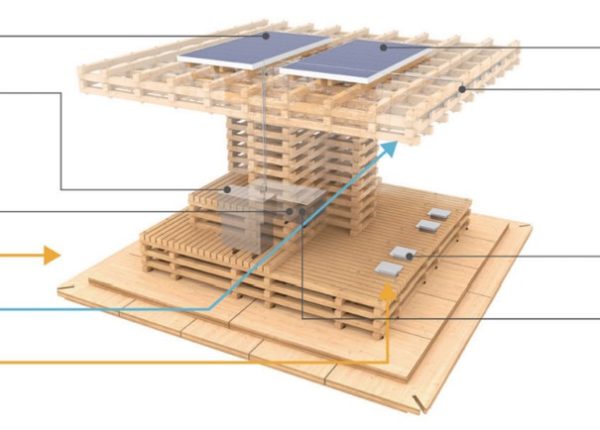The concrete jungles of large cities can be quite challenging, as the pavement and walls of buildings heat up under the scorching sun. Pedestrians are cooked not just from the sun above, but from all sides, as the concrete emanates heat. High-rise buildings block proper airflow, and solid lines of cars on the streets kick up dust and fumes, which makes everyone want to leave the city.
A consortium of four companies from Japan has responded to such concerns by launching Cool Tree Lite. The companies – Nikken Sekkei, Meiken Lamwood, Murata Manufacturing, and Koei – joined forces in 2018 to develop a solar-powered cooling refuge for cities. Just like a tree, it is made from wood, spreads water vapor, and provides shade.

The companies are promoting the product as a “cool spot” for cities. The structure features a 4.8m² bottom plate and a 4m² roof. A cypress-wood sitting area occupies the space in between, but the highlight is the two solar modules that are mounted onto the top of the structure. The modules charge a battery hidden away in the “stem” of the structure, and the battery powers Peltier effect cooling plates that have been integrated into the sitting area.
There is also a vaporizer in the roof of the structure. The solar-powered vaporizers spread a pleasant mist, and the roof features a crosshatch that blocks out direct sunlight.
Cool Tree Lite is made from cypress wood, and for that, so it requires bolts, rather than glue. The structure can be disassembled and reassembled at different spots as needed on certain days of the year, and for special events.
Thanks to the two solar panels and battery, the system is entirely off-grid and self-sufficient. The consortium adds that there is no need to plug the system into a power source.
Popular content
The first system, installed in Tokyo, can be used freely from May to September. During the night, passersby can charge their phones with it.
The group is not the first to to produce solar-powered “urban furniture”. Engie made headlines in France last summer after Guillaume Barucq, an official in the municipal government of Biarritz, tweeted his enthusiasm for a number of solar benches that the power group had installed in the small coastal city.
Amusingly, Barucq also urged citizens not to sit on the benches for long periods of time, due to concerns that seated bottoms could reduce their energy yield. Dozens of social media users quickly mocked his comments.
While a lack of power supply due to prolonged sitting breaks would not be an issue in Japan, elderly people should be careful about sitting for excessively long periods on the Peltier effect plates.
In Australia, Adelaide-based Specialised Solutions has introduced solar-powered benches, which can offer shade, lighting, Wi-Fi, and charging ports to those in need.
This content is protected by copyright and may not be reused. If you want to cooperate with us and would like to reuse some of our content, please contact: editors@pv-magazine.com.



Spraying water mist to evaporate can help people feel cool, but that vapor sticks around and keeps the area warm at night.
It’s better to have high albedo surfaces facing up to reflect the sun’s heat back into space rather than being absorbed in the first place. It provides shade and does more to keep the area cool 24 hr a day.
I request PV Magazine to publish about “Net-Metering” in different countries from Europe, Americas and Asia…how long is the application process, the application fees, buying rates of the generated electricity by grid companies, etc. It is sad to know that in the Philippines application processes & fees takes an average of 6 months with hefty fees.
Only two panels??? I think we can do better than that…plus all the shade of buildings and other trees…
Am I the only one seeing this a pure nonsense ?
Though solar technology and energy is a must go in our societies, this particular problem of hot spots in urban area should be, in my book, addressed with vegetalisation and not this kind of urban furniture.
Think of it as too much emissions+urbanisation)-> hotspots -> more emissions + urbanisation logic.
Even with photovoltaics, even with high energy efficiency and whatsoever, in regard of environnemental impact as a whole this kind of product is a wrong choice.
That’s an opinion, with some quite harsh words and positions, but feel free to dicuss it I’d be glad to.
thanks for keeping us updated on the latest happenings in solar pv systems
Good idea.
Public bus stops with this type of arrangement
maybe useful.